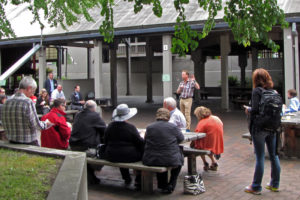
The Fremont Chamber of Commerce held its annual Picnic In The Park on June 18th and, as often is the case, in addition to a delicious lunch (by Cameron Catering) the attendees discussed politics.
Every other year the Chamber hosts a Picnic with candidates for Seattle City Council seats. This year, when no Council elections will take place, attendees discussed a far-reaching change coming to City Council politics – district elections.
An Overview Of #6 & #4
Last November, 65.92% of Seattle voters approved Charter Amendment 19, which divides the City Council into seven districts. In 2015, all nine Council seats go up for election – with seven elected by districts (Fremont voters west of Aurora will vote in District #6 with Ballard, and east of Aurora will vote in District #4 with the U-District, Laurelhurst, and Wedgewood,) and two elected city-wide.
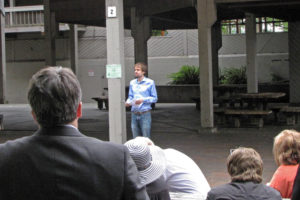
The Chamber invited Benjamin Anderstone, a political consultant, to speak on the voter demographics of our two districts. Anderstone spoke with confident authority, giving a detail-rich overview of the kinds of voters that live here. District #6 is very well off, with the highest voter turnout, and very white although it also has a light industry/maritime base that, “haven’t been big supporters politically in the past,” Anderstone observed, but “now these are the biggest players in commerce,” in our district. District #4 is city-wide the most educated, second poorest (a large amount of rental dwellings attract students and immigrants,) and often provides a bellwether for the whole city – this district votes the way the City does as a whole. The district system may give the University of Washington a larger voice that it has used before.
Finding Candidates
For all Anderstone spoke about demographics, and answered questions, many attendees I spoke with didn’t get what they wanted from this meeting – an understanding of just what district elections will look like, and how they will operate. Some attendees actually worked to make districts a reality, but others came to the Picnic seeking more information on what this means.
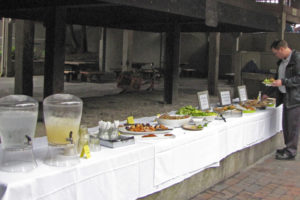
Barry North, a health care practitioner, lives and works in District #3, and he voiced on the record what several other people wouldn’t. “I need to be educated,” he admitted, “I would like to know who [the candidates] are, and to have meetings.” Everyone expressed an eagerness to meet their candidates, to know who they will be, and to converse with them. “I want to meet other business people, and meet the candidate, and hear what gets said,” North explained.
Since last November, rumors have run rampant about who may run, and who will not. Former Seattle City Councilmember Peter Steinbrueck attended the Picnic In The Park, and stated clearly that he is not a candidate. Candidates can file to run up to May 15, 2015, but who might do so – including among current Councilmembers – are a hot and juicy topic.
According to Anderstone, current Councilmember Nick Licata may run for a city-wide seat. Councilmember Jean Godden has filed with the Seattle Ethics & Elections Commission to run for District #4, while Tim Burgess and Sally Clark have filed for the two at-large positions (#8 & #9 respectively.) No one has filed for District #6.
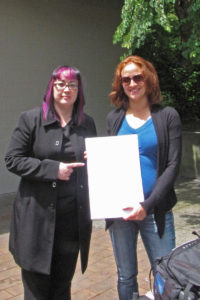
Issues, Concerns & Observations
While some still don’t understand the system, attendees at the Picnic do have concerns to share with candidates when they decide to run.
Ken Phillips Jr., of U-Park System, came ready to talk taxes – city taxes paid by businesses. Taxes are paid by all businesses, but depending on what they do, they pay different amounts. Phillips had research that showed that for $1 million in revenue professional services providers (lawyer, doctor, CPA) pay $4,150 in taxes. A retail business (from Nordstrom to an independent boutique) pays $99,150 in city taxes. A business that sells parking spaces – like U-Park lots that provide places for Fremont events – pays $224,150 in taxes.
Marko Tubic, who lives in District #7 but works in #6 at his Edward Jones office, spoke on, “what feels like an assault on small business. I feel it is favoring very large companies,” he said, “making it harder and harder to operate. If the residential homeowner, of which I am one, had to pay the level of taxes that they do, there would be a revolt.” Tubic also commented on the Downtown-centric transportation system our City has, and the sense of an increase in ridership while service decreases.
Jeremy Johnsen lives in District #6, and works in #6, #4 and #7, along with all the other districts. Johnsen works for Moisture Festival and Orchestra Seattle, which perform around our entire region. He came to the Picnic to better understand the district system, but he also remarked on a shift he sees happening in the foundation of our city. “There is so much money pouring in that it can become lopsided,” he observed, “it becomes large corporations.” He wants to see the small-town feel of Seattle maintained, along with community representation. With the districts divided by population – currently no district differs in population from any other district by more than 1% – Johnsen hopes that deep pockets cannot overwhelm city politics, and policies.
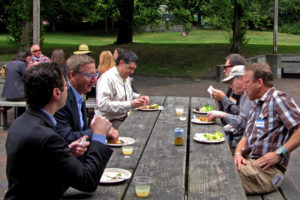
Mark Grey, a property manager with Stephen C. Grey & Associates, lives in District #4 but he – like many of the business people I spoke with – works in all of them. His primary issue at present is safety and security in our community. “The dump is closed,” he joked ruefully about temporary closure of the North Seattle Transfer Station, “but the dump is open in North Seattle.” Tenants in Fremont, who could lease space anywhere, see graffiti, dumped trash, and the effects of crime as they drive to and from their offices and warehouses. “We want to make sure our police have the resources they need to be effective,” he said, “and the support they deserve.”
For Now…
One more Fremont small business owner, Angela Cough, attended the Picnic about a much more urgent political issue. She volunteers with Forward Seattle, collecting signatures to put a referendum on the November ballot to allow a vote on the recently developed $15 minimum wage ordinance #124490. “We are all going to be on the hook if this goes in,” she said, “we want to provide a choice. It would still be up to the people to vote yes, or no.”
This is Cough’s first real political effort. She is working with other small business owners who went to the Mayor’s Office, and the City Council, to give input on the matter of the minimum wage. “They were largely disregarded,” Cough observed. About the current Council, “they have no direct responsibility,” she said, while under the district system, “if something like this comes up again, you can go straight to your representative.”
According to Anderstone, each Seattle voting district represents about five or six neighborhoods. “Candidates can lock up the support of neighborhood groups,” he said, “It is definitely more opportunity for neighborhood groups to find some unifying, and push, on issues.”
The Fremont Chamber, as well as other neighborhood groups, will be able, under the district model, to hold events like the Picnic and give members/attendees a voice with at least one member of the City Council.
If you want to find out about future Chamber gatherings, and how to add your voice to theirs, contact director@fremont.com or visit the website Fremont.com about their next events.
Related Articles
- Showing Up For A Picnic, & Democracy
- by Kirby Lindsay, June 24, 2013
- Parking Tax Anxiety
- by Kirby Lindsay, July 12, 2006 in the North Seattle Herald-Outlook
- What Is Charter Amendment 19?
- by Kirby Lindsay, October 21, 2013
©2014 Kirby Lindsay. This column is protected by intellectual property laws, including U.S. copyright laws. Reproduction, adaptation or distribution without permission is prohibited.

